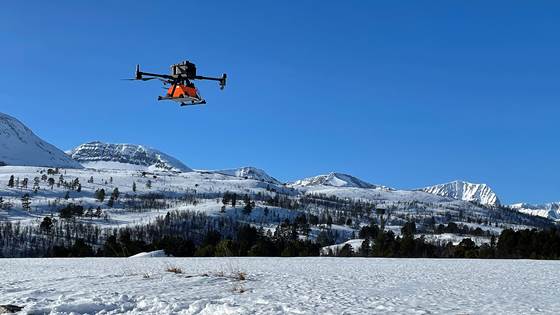For the country’s farmers, this means loss of livelihood, and for Europe, weakened food security.
Researchers and students from the Massachusetts Institute of Technology (MIT) are now collaborating with SINTEF to develop groundbreaking technology that can map dangerous areas faster and more accurately than ever before. The project, called RETRACE (Remote Targeted Remediation and Contamination Evaluation), combines advanced sensors, drones, and artificial intelligence to identify contaminated soil and explosives.
World-leading technology in action
At Tarva in Trøndelag and at the Nammo facility in Raufoss, SINTEF and MIT students are testing drone-based technology to make mine clearance safer and more efficient. The drones are equipped with ground-penetrating radar, magnetometers, radiometric and multispectral cameras that collect data from the terrain. This data is then analyzed using machine learning models to identify hazards with high precision.
The goal is to develop a drone-based mapping routine that is fast, repeatable, and reliable, says researcher and project manager Madeline Lee, SINTEF.
When life and land are at stake
In the Kharkiv region, farmers like Oleh Hirman and Hennadi Morhun have experienced the consequences of war firsthand. Hirman was paralyzed after stepping on a mine, while Morhun has managed to clear only four of his 30 hectares of land. Still, he has started farming again, a sign of hope for a better future.
Switlana Solomentseva, a pharmacist who fled to Sweden with her son, returned to Ukraine as a deminer. She operates a remote-controlled tractor and is one of many risking their lives to make the country safe again.
These stories are featured in The Boston Globe in the article:"Hope in a minefield: How MIT students are helping Ukrainian farmers reclaim their land"
From student project to global mission
RETRACE has emerged as a collaboration between SINTEF and the MIT Ukraine Program, an international platform led by researchers at MIT. The program brings together technology communities, volunteer organizations, and MIT’s global alumni network to support democracies facing war and crises. The project originated from previous research on soil contamination from remnants of war, including how cattle can be exposed to waste from shooting ranges.
The MIT Ukraine Program explores innovative solutions for repurposing technology, for example by converting retired military drones into affordable and effective systems for detecting mines, explosives, and environmental toxins. At the same time, SINTEF leads the collection of measurement data from its own drones and the work of characterizing various types of pollution and hazards, based on advanced sensors. MIT has contributed with the development of software and graphical interfaces that make it easier to analyze and visualize the data.
SINTEF aims to contribute to land restoration and is now developing further collaboration with both volunteer organizations and defense research environments, with the goal of making the technology available to more people working to ensure safe and sustainable societies.
The project supports several of the UN Sustainable Development Goal
- Goal 3: Good health and well-being by reducing exposure to explosives and environmental toxins
- Goal 13: Climate action by making contaminated agricultural land usable again
- Goal 15: Life on land by restoring ecosystems and reducing risk for people and animals



